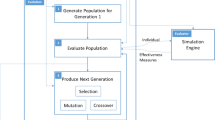Abstract
The paper uses ideas from Machine Learning, Artificial Intelligence and Genetic Algorithms to provide a model of the development of a ‘fight-or-flight’ response in a simulated agent. The modelled development process involves (simulated) processes of evolution, learning and representation development. The main value of the model is that it provides an illustration of how simple learning processes may lead to the formation of structures which can be given a representational interpretation. It also shows how these may form the infrastructure for closely-coupled agent/environment interaction.
Similar content being viewed by others
References
Barnett, S. (1973), Ethology and Development, Heinemann Medical.
Boden, M. (1979), Piaget, Fontana Modern Masters, Fontana Press.
Bolles, R. (1979), Learning Theory (2nd edition), New York: Holt.
Braitenberg, V. (1984), Vehicles: Experiments in Synthetic Psychology, London: The MIT Press.
Cliff, D., Husbands, P. and Harvey, I. (1993), ‘Evolving visually guided robots’, in J. Meyer, H. Roitblat and S. Wilson (Eds.), From Animals to Animats: Proceedings of the Second International Conference on Simulation of Adaptive Behaviour(SAB92). MIT/Bradford Books.
Feder, M. and Lauder, G. (Eds.) (1986), Predator-Prey Relationships. Perspectives and Approaches from the Study of Lower Vertebrates, Chicago and London: University of Chicago Press.
Flaherty, C. (1985), Animal Learning and Cognition, New York: Knopf.
Gerlai, R. (1993), ‘Can paradise fish (macropodus opercularis anabantidae) recognize a natural predator. an ethological analysis’, Ethology 94, pp. 127-136.
Goldberg, D. (1989), Genetic Algorithms in Search, Optimization, and Machine Learning, Addison-Wesley.
Holland, J. (1975), Adaptation in Natural and Artificial Systems, Ann Arbor: University of Michigan Press.
Karmiloff Smith, A. (1992), Beyond Modularity: A Developmental Perspective on Cognitive Science, Cambridge, Ma.: MIT Press/Bradford Books.
K-Team, (1993), Khepera Users Manual. Lausanne: EPFL.
Muggleton, S. (Ed.) (1992), Inductive Logic Programming, Academic Press.
Nolfi, S., Floreano, D., Miglino, O. and Mondada, F. (1994), ‘How to evolve autonomous robots: different approaches in evolutionary robotics’, in R. A. Brooks and P. Maes (Eds.), Proceedings of Artificial Life IV (pp. 190-197).
Quinlan, J. (1986), ‘Induction of decision trees’, Machine Learning 1, pp. 81-106.
Rumelhart, D., Hinton, G. and Williams, R. (1986), ‘Learning representations by back-propagating errors’, Nature 323, pp. 533-6.
Rumelhart, D. and Zipser, D. (1986), ‘Feature discovery by competitive learning’, in D. Rumelhart, J. McClelland and the PDP Research Group (Eds.), Parallel Distributed Processing: Explorations in the Microstructures of Cognition. Vol I (pp. 151-193). Cambridge, Mass.: MIT Press.
Shavlik, J. and Dietterich, T. (Eds.) (1990), Readings in Machine Learning, San Mateo, California: Morgan Kaufmann.
Thornton, C. (1994), ‘Unsupervised learning with the soft-means algorithm’, Proceedings of the World Congress on Neural Networks, Vol. 4 (pp. 200-205 (v. 4)). San Diego.
Thornton, C. (1995a), ‘Measuring the difficulty of specific learning problems’, Connection Science 7 (No. 1), pp. 81-92.
Thornton, C. (1995b), ‘Compression, dilation and the redescriptive role of explicitation’, in J. Hoc (Ed.), Proceedings of the European Conference on Cognitive Science (pp. 19-30).
Wilson, S. (1991), ‘The animat path to AI’, in J. Meyer and S.W. Wilson (Eds.), Proceedings of the First International Conference on the Simulation of Adaptive Behaviour (From Animals to Animats) (p. 16). Cambridge: MIT Press.
Author information
Authors and Affiliations
Rights and permissions
About this article
Cite this article
Thornton, C. Brave Mobots Use Representation: Emergence of Representation in Fight-or-Flight Learning. Minds and Machines 7, 475–494 (1997). https://doi.org/10.1023/A:1008206631439
Issue Date:
DOI: https://doi.org/10.1023/A:1008206631439




